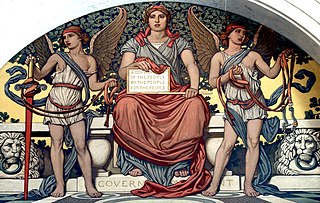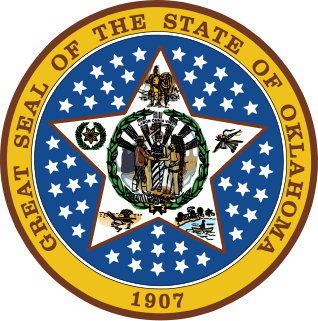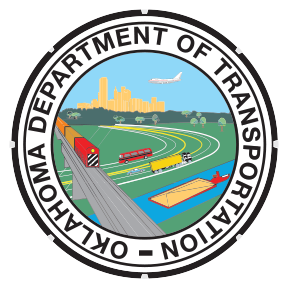
The United States federal budget comprises the spending and revenues of the U.S. federal government. The budget is the financial representation of the priorities of the government, reflecting historical debates and competing economic philosophies. The government primarily spends on healthcare, retirement, and defense programs. The non-partisan Congressional Budget Office provides extensive analysis of the budget and its economic effects. It has reported that the U.S. is facing a series of long-term financial challenges, as the population of the country ages and healthcare costs continue growing faster than the economy, leading to the debt held by the public exceeding GDP by 2030. The United States has the largest external debt in the world and the 14th largest government debt as % of GDP in the world.
The budget of the United States government for fiscal year 2007 was produced through a budget process involving both the legislative and executive branches of the federal government. While the Congress has the constitutional "power of the purse," the President and his appointees play a major role in budget deliberations. Since 1976, the federal fiscal year has started on October 1 of each year.
The United States federal budget for fiscal year 2009 began as a spending request submitted by President George W. Bush to the 110th Congress. The final resolution written and submitted by the 110th Congress to be forwarded to the President was approved by the House on June 5, 2008.
Kansas, like many other states, is facing a $186 million gap for fiscal year 2009 and according to early estimates approximately $1 billion deficit for fiscal year 2010. However, more recent estimates place FY 2010's shortfall at $654 million.
Governor Kathleen Sebelius recommended $600 million in budget cuts for FY 2010 which includes eliminating programs, closing facilities, freezing new hires, and reducing spending. However, in light of the federal economic stimulus package Sebelius amended her recommended budget to "prevent harm" to the state. "Budget cuts deeper than what I have already recommended are not necessary, and would in fact do great harm to our state’s economy and employment levels," said Sebelius. However, state officials said their target for reductions in fiscal 2010 is greater than the Governor's recommendations - $625 million. According to the Governor's recommended budget, the proposed cuts could reduce the projected FY2010 shortfall $103 million, however that estimate depends on $57 million in revenue from state-owned casinos that haven’t yet been built.
The United States Federal Budget for Fiscal Year 1997, was a spending request by President Bill Clinton to fund government operations for October 1996-September 1997. Figures shown in the spending request do not reflect the actual appropriations for Fiscal Year 1997, which must be authorized by Congress. The requested budget was submitted to Congress on February 5, 1996.
The 2011 United States federal budget was the United States federal budget to fund government operations for the fiscal year 2011. The budget was the subject of a spending request by President Barack Obama. The actual appropriations for Fiscal Year 2011 had to be authorized by the full Congress before it could take effect, according to the U.S. budget process.

The Oklahoma State Budget for Fiscal Year 2011, is a spending request by Governor Brad Henry to fund government operations for July 1, 2010–June 30, 2011. Governor Henry and legislative leader approved the budget in May 2010. This was Governor Henry's eight and final budget submitted as governor.
The Oklahoma State Budget for Fiscal Year 2005, was a spending request by Governor Brad Henry to fund government operations for July 1, 2004–June 30, 2005. Governor Henry and legislative leader approved the budget in May 2004.
The Oklahoma State Budget for Fiscal Year 2006, was a spending request by Governor Brad Henry to fund government operations for July 1, 2005–June 30, 2006. Governor Henry and legislative leader approved the budget in May 2005.
The Oklahoma State Budget for Fiscal Year 2001, was the spending request by Governor Frank Keating to fund government operations for July 1, 2000–June 30, 2001. Governor Keating and legislative leader approved the budget in May 2000. This was Governor Keating's sixth budget submitted as governor.
The Oklahoma State Budget for Fiscal Year 2007, was a spending request by Governor Brad Henry to fund government operations for July 1, 2006–June 30, 2007. Governor Henry and legislative leader approved the budget in May 2006.
The Oklahoma State Budget for Fiscal Year 2008, was a spending request by Governor Brad Henry to fund government operations for July 1, 2007–June 30, 2008. Governor Henry and legislative leader approved the budget in May 2007.

The Oklahoma State Budget for Fiscal Year 2012, is a spending request by Governor Mary Fallin to fund government operations for July 1, 2011–June 30, 2012. Governor Fallin proposed the budget on February 7, 2011. This was Governor Fallin's first budget submitted as governor.
The Oklahoma State Budget for Fiscal Year 2010, is a spending request by Governor Brad Henry to fund government operations for July 1, 2009–June 30, 2010. Governor Henry and legislative leader approved the budget in May 2009.
The 2013 United States federal budget is the budget to fund government operations for the fiscal year 2013, which is October 2012–September 2013. The original spending request was issued by President Barack Obama in February 2012.

The Oklahoma State Budget for Fiscal Year 2013, is a spending request by Governor Mary Fallin to fund government operations for July 1, 2012–June 30, 2013. Governor Fallin proposed the budget on February 6, 2012. This was Governor Fallin's second budget submitted as governor.
The Oklahoma State Budget for Fiscal Year 2009, was a spending request by Governor Brad Henry to fund government operations for July 1, 2008–June 30, 2009. Governor Henry and the Legislature approved the budget in May 2008.

The Oklahoma State Budget for Fiscal Year 2014, is a spending request by Governor Mary Fallin to fund government operations for July 1, 2013–June 30, 2014. Governor Fallin proposed the budget on February 4, 2013. This was Governor Fallin's third budget submitted as governor.

The Oklahoma State Budget for Fiscal Year 2015, is a spending request by Governor Mary Fallin to fund government operations for July 1, 2014 – June 30, 2015. Governor Fallin proposed the budget on February 3, 2014. This was Governor Fallin's fourth budget submitted as governor.









